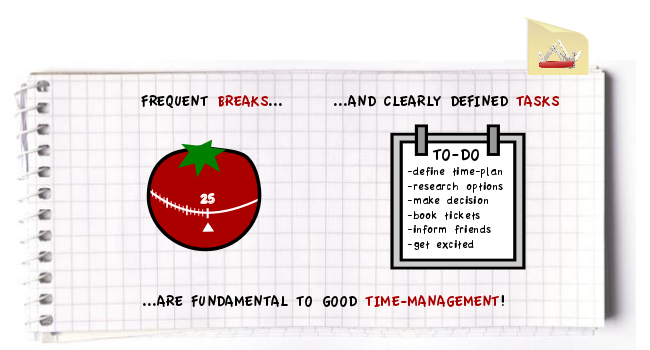Warning: file_get_contents(): php_network_getaddresses: getaddrinfo failed: Name or service not known in /www/htdocs/w00e5436/Handbook/wp-content/plugins/digg-digg/include/dd-class.php on line 1202
Warning: file_get_contents(http://feeds.delicious.com/v2/json/urlinfo/data?url=http%3A%2F%2Fhandbookofawesome.com%2F2011%2F12%2Fpomodoro-technique%2F): failed to open stream: php_network_getaddresses: getaddrinfo failed: Name or service not known in /www/htdocs/w00e5436/Handbook/wp-content/plugins/digg-digg/include/dd-class.php on line 1202
“The successful warrior is the average man, with laser-like focus.” (Bruce Lee)

Most people have poor focus. You try to concentrate on a single task for an extended period of time and wind up being constantly interrupted: a colleague drops in to say hi, your grandmother calls to find out why you never visit or Adobe asks you to update and reboot. It’s only in employers’ wet dreams that people are able to work intently for hours on end, never once pausing to procrastinate or daydream. The issue is not just related to the office; anyone who’s ever worked from home knows there’s an entire horde of distracters lurking around there as well. Unfortunately, if you’ve set clear goals for yourself for the day (you should have as per our post on MITs), poor focus will lead to longer hours, as you need more time to get shit done.
In the 80s (surely the most awesome decade ever) Francesco Cirillo invented a simple but powerful time management tool called the “Pomodoro”-technique (“pomodoro” is Italian for “tomato”). Mr. Cirillo basically conceded that people tend to have very limited spans of attention, and instead of trying to change that rather worked around it, allowing for plenty of short breaks amid work. The theory goes that basically, the maximum attention span you can demand from anyone is about 25 minutes, i.e. one “Pomodoro”. After 25 minutes of focused work, you deserve a break of 5 minutes before starting on a new Pomodoro.
Thus, you need to divide your daily to-do list into tasks you estimate will take 25 minutes, dicing larger activities ruthlessly so they fit into this period. Longer 30-minute breaks are taken after four consecutive Pomodoros. The idea is that the frequent breaks allow you to focus more intently during the relatively short periods when it is required, thus speeding up your progress. Also, Pomodoros form a great productivity metric you can use to track your own daily development.
Here are five simple steps to get you started:
- Define a Pomodoro-sized task, something you think will take 25 minutes.
- Get rid of all unnecessary distractions: close your mail program, unneeded browser windows and if possible, shut the door to your office.
- Get a good old-fashioned kitchen timer and set it to 25 minutes. Some people actually prefer to have a loudly ticking one that lends a sense of urgency to your work. As usual, there’s also a range of custom-built Pomodoro-apps available, e.g. this free one.
- Work on the task with the clear aim of finishing it before the timer goes off. If you finish early, devote the rest of the time to reviewing your work. Do not start a new task.
- Once the timer rings, tick the Pomodoro off your to-do list and take a short 5-minute break where you do nothing work-related. After four Pomodoros take a longer 30-minute break.
This technique is especially handy when you’re having an off-day and still want to be productive. You can find more advanced guidance on the topic here.









